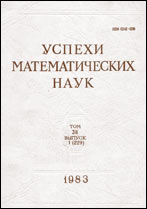|
This article is cited in 14 scientific papers (total in 15 papers)
Regular Markov processes
E. B. Dynkin
Abstract:
This article is concerned with the foundations of the theory of Markov processes. We introduce the concepts of a regular Markov process and the class of such processes. We show that regular processes possess a number of good properties (strong Markov character, continuity on the right of excessive functions along almost all trajectories, and so on). A class of regular Markov processes is constructed by means of an arbitrary transition function (regular re-construction of the canonical class). We also prove a uniqueness theorem.
We diverge from tradition in three respects:
a) we investigate processes on an arbitrary random time interval;
b) all definitions and results are formulated in terms of measurable structures without the use of topology (except for the topology of the real line);
c) our main objects of study are non-homogeneous processes (homogeneous ones are discussed as an important special case).
In consequence of a), the theory is highly symmetrical: there is no longer disparity between the birth time $\alpha$ of the process, which is usually fixed, and the terminal time $\beta$, which is considered random.
Principle b) does not prevent us from introducing, when necessary, various topologies in the state space (as systems of coordinates are introduced in geometry). However, it is required that the final statements should be invariant with respect to the choice of such a topology.
Finally, the main gain from c) is simplification of the theory: discarding the “burden of homogeneity” we can use constructions which, generally speaking, destroy this homogeneity.
Similar questions have been considered (for the homogeneous case) by Knight [8],
Doob [2], [3] and other authors.
Citation:
E. B. Dynkin, “Regular Markov processes”, Russian Math. Surveys, 28:2 (1973), 33–64
Linking options:
https://www.mathnet.ru/eng/rm4861https://doi.org/10.1070/RM1973v028n02ABEH001529 https://www.mathnet.ru/eng/rm/v28/i2/p35
|


|




 Contact us:
Contact us: Terms of Use
Terms of Use
 Registration to the website
Registration to the website Logotypes
Logotypes








 Citation in format
Citation in format 
